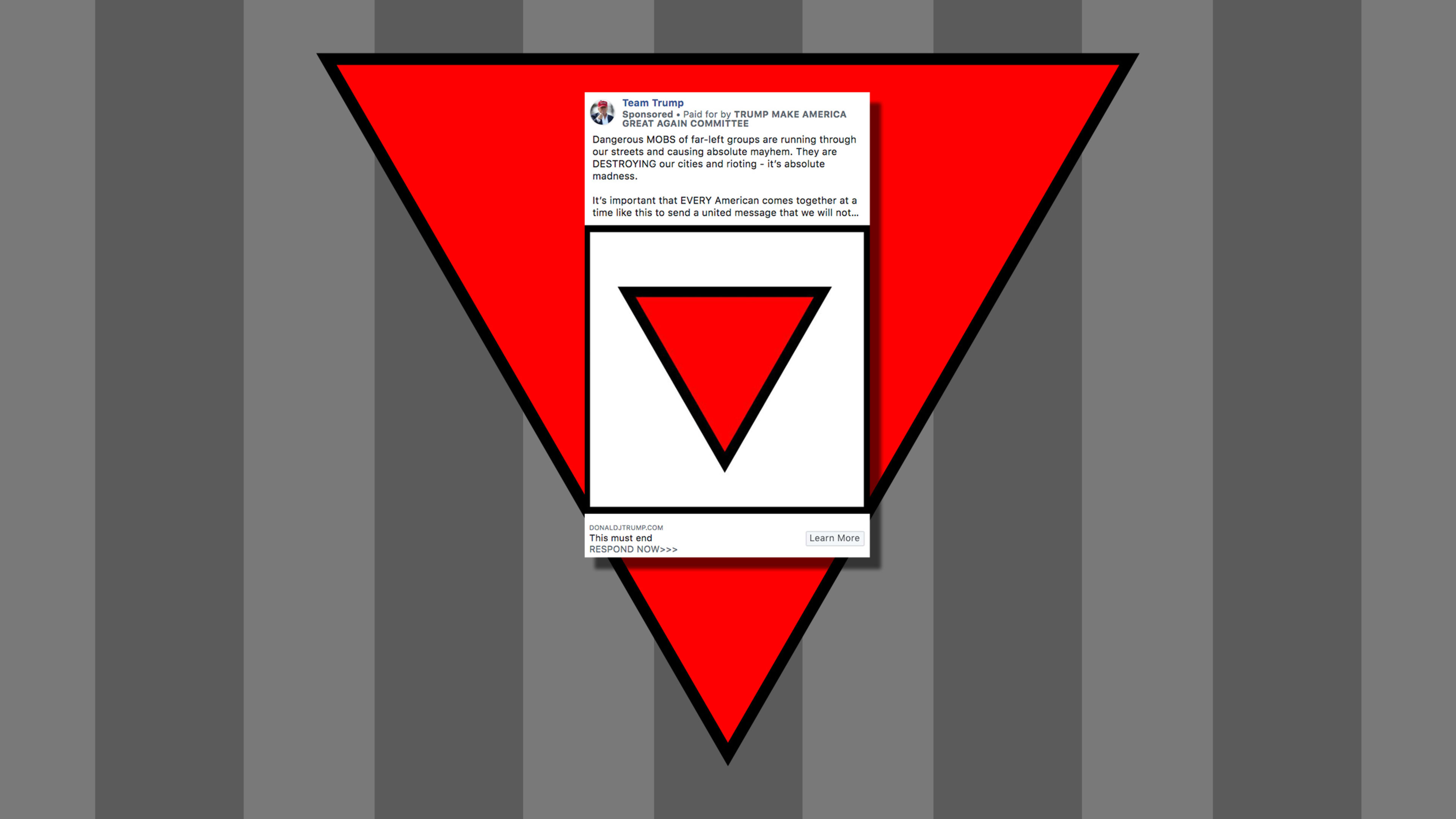The Trump campaign began running ads on June 3 asking Americans to “make a public statement and add your name to stand with President Trump against ANTIFA.” The visual on some of those ads was an inverted red triangle. And though the ads have been running for weeks, they were just removed by Facebook, after a MediaMatters story on them published today. A Facebook spokesperson told MediaMatters in a statement that they removed the posts in question “for violating our policy against organized hate. Our policy prohibits using a banned hate group’s symbol to identify political prisoners without the context that condemns or discusses the symbol.” Here’s everything you need to know about this symbol of hate.
What is the symbol’s origin?
Inverted triangles were used for a prisoner classification system in Nazi concentration camps during World War II. The triangles acted as quickly identifiable badges, and were sewn onto the uniforms of prisoners in the camp so SS officers could identify a prisoner’s alleged reason for incarceration based on the color of the triangle they wore, according to the United States Holocaust Memorial Museum. A red triangle signified political prisoners—people Nazi Germany incarcerated for their political views. In fascist Germany, the political opposition included anti-Nazi and anti-fascist leftist groups, like Communists, Social Democrats, liberals, anarchists, and others. Which political point of view did the Trump ad refer to? “MOBS of far-left groups.”
What does it mean?
It’s not hard to see that the campaign directly connects the symbol to the ad’s call to action: for people to “stand with your President and declare ANTIFA a Terrorist organization.” Trump has falsely claimed that antifa—short for “anti-fascist,” a kind of loose term with which varying groups on the political far-left identify—was behind acts of violence during protests in response to the killing of George Floyd, and also tweeted a conspiracy theory falsely claiming a 75-year-old peaceful protester knocked down in Buffalo, New York, was affiliated with the ideology.
The President of the United States is campaigning for reelection using a Nazi concentration camp symbol.
Nazis used the red triangle to mark political prisoners and people who rescued Jews.
Trump & the RNC are using it to smear millions of protestors.
Their masks are off. pic.twitter.com/UzmzDaRBup
— Bend the Arc: Jewish Action (@jewishaction) June 18, 2020
Jonathan Greenblatt, CEO of the Anti-Defamation League, told NPR that, “Intentionally or otherwise, using symbols that were once used by the Nazis is not a good look for someone running for the White House. It isn’t difficult for one to criticize a political opponent without using Nazi-era imagery.”
Greenblatt was not the only to find use of the symbol troubling. “I think it’s a highly problematic use of a symbol that the Nazis used to identify their political enemies,” Jacob S. Eder, a historian of modern Germany at the Barenboim-Said Akademie in Berlin told The Washington Post. “It’s hard to imagine it’s done on purpose, because I’m not sure if the vast majority of Americans know or understand the sign, but it’s very, very careless, to say the least.”
The general public might not be aware of the symbol’s meaning, but that’s beside the point. Symbols associate members of a group. They can be dog whistles—you just have to be in the know enough to recognize one. If you’re not the target audience, or you don’t have an association with far-right-wing groups, you might scroll right past. But if the Trump campaign is targeting you with ads because of, say, previous activity on Facebook, you might be more clued into what it means. It’s a historically fascist symbol, used in anti-left messaging. The call to action is there if you know what to look for.
What has Trump’s response been?
The Trump campaign is playing innocent, saying the symbol is an emoji (ah, that clears things up!) and falsely claiming that “it’s a symbol widely used by antifa,”citing a poster on a site called Spreadshirt. A quick image search for “antifa symbols” only shows red inverted triangles associated with antifa related to this breaking news.
Sure, the majority of people might be unaware of the triangle’s origins. But it’s a loud statement for those who do, and adds yet another page to the importance of semiotics. There are other hidden, symbolic meaning in words and numbers if you know what to look for. Renowned graphic designer Mirko Ilic has lectured on symbols of hate for years. His talks called out two other numerical symbols of hate that have gotten less attention in today’s news: the numbers 14 and 88. The first sentence in the ad has 14 words, a way to allude to a white supremacist slogan, according to the Anti-Defamation League (ADL). On June 17, the campaign ran 88 ads with the inverted red triangle across Facebook pages for Trump, Mike Pence, and Team Trump. Eighty-eight signifies the eighth letter in the alphabet—H—and when paired, is a numerical code meaning “heil Hitler,” and a white supremacist symbol, according to ADL. Is that what the Trump campaign had in mind? If they did, they haven’t admitted to it. And it took public outcry for Facebook to remove the ads featuring the red inverted triangles. But it just goes to show what might be hiding in plain sight—and the power in knowing what seemingly mundane symbols actually mean.
Recognize your brand’s excellence by applying to this year’s Brands That Matter Awards before the early-rate deadline, May 3.
